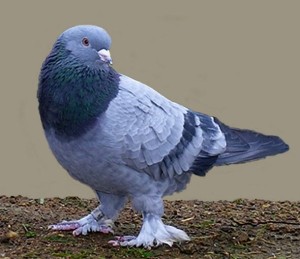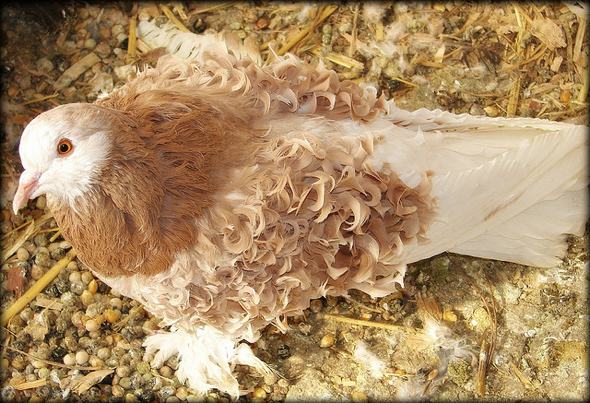
Takla Tumbler – photo by Jim Gifford
The pigeons which, although at first glance looked all the same, were very different one from the other. Nature gave them incredible abilities and unusual colours. Some were reddish and white and others blue-grey and white. Furthermore their particular behaviour in dangerous situations differed from that of any other bird.
Once this friend of mine invited me to go to his house to see what he called his flying pets and what they were able to do.
He explained to me that these pigeons in the wild have learnt to escape from the eagles and hawks, that were always hunting them. Therefore the poor pigeons had been forced to learn a method to save themselves from been eaten by the bigger birds.

English Long Faced Muffed Tumbler – photo by Jim Gifford
After having fallen for many meters they regain their flying position and like rockets shoot off in another direction. This leaves the unfortunate eagle fifty meters higher without a clue to where they have gone and thus they made a narrow escape once again.
After school my friend spent hours and hours on the house roof with different whistles in his hand. The pigeons flew high up in the sky in a big circle obeying to his orders. Each whistle had a specific meaning to which the birds responded and obeyed. One whistle was for them to go up and another to come down. Yet another was for older pigeons to somersault. Maybe to show the younger ones how it should be done, because they learn this technique by imitation. My friend had many other whistles in his pocket and I didn’t know what they were for. I spent an afternoon with him on the roof and after looking at the pigeons going round and round, I got extremely dizzy so I had to sit down. My friend just kept the pigeons flying and tumbling for a long time.

Fantail Pigeon – photo by awayukin
He thought it was great fun. He also had other pigeons which he would put on show, such as fantails that walked around trying to imitate a turkey. I saw them spread their tails like a fan and walked around beating their heels (if they had any). They held their heads up high in pride showing off, like only pigeons can do. He showed me another loft where he kept his special pigeons for shows only. There were some with curly feathers and it looked as if they had just been to a feather dresser’s boutique and had their feathers curled.

Frillback Pigeon – photo by Jennifer Graevell
Some pigeons tumbled until they got very close to the ground. After giving a new command with another whistle the birds flew away to join the group again, ready for another round.
From what I saw, they never disobeyed an order and seemed to have great fun.
After having read this story, those who still think that pigeons are only useful for making pigeon pies, had better think again!




 I got my inspiration for this website from the song called “Imagine”, and so I decided to go on this adventure. I have always wanted to put up something like this where my friends and I could express our memories and dreams for the future. Share them with us, because if many people dream the same dream it will certainly come true.
I got my inspiration for this website from the song called “Imagine”, and so I decided to go on this adventure. I have always wanted to put up something like this where my friends and I could express our memories and dreams for the future. Share them with us, because if many people dream the same dream it will certainly come true.
Wow, that’s interesting! I didn’t know there were so many different types of pigeons!